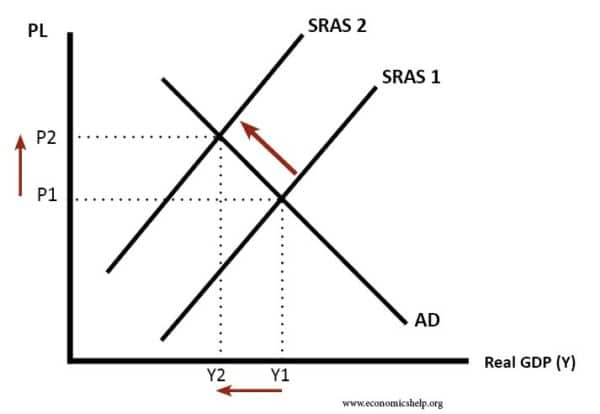Which of the Following Best Describes Supply Side Economics
Supply-side economics is a macroeconomic theory arguing that economic growth can be most effectively created by lowering taxes and decreasing regulation by which it is directly opposed to demand-side economics. Education impacts the incentive to work save and invest and therefore.

The Role Of Supply Side Policies In A Recession Economics Help
The money supply shifts right prices rise demand curve shifts left.

. Up to 256 cash back A proponent of supply-side economics would advocate. An economic theory advocated by President Reagan holding that too much income goes to taxes so too little money is available for purchasing and the solution is to cut taxes and return purchasing power to consumers. The supply-side fiscal policy offers incentives to the producers Ask a question.
The simplest answer is the law of supply and demand. Supply-side economics is better known to some as Reaganomics or the trickle-down policy espoused by 40th US. B Tax rates particularly marginal tax rates affect the incentive to work save and invest and therefore aggregate supply.
What is supply-side economics AP Gov. Asked Dec 24. Which of the following best describes supply side economics.
Economic policy of shielding an economy from imports. C eliminating the depreciation allowance. Which of the following statements best describes the study of economics.
Which of the following best describes supply-side economics. A reducing income taxes on saving. Lower taxes on research and development of new technology.
C Education affects the incentive to work save and invest and therefore aggregate supply. Education affects labor productivity which affects aggregate supply. Labor productivity affects aggregate supply.
2 The tax wedge is the difference between the A pre-tax and post-tax returns to an economic activity. B Education affects labor productivity which affects aggregate supply. C Education affects the incentive to work save and invest and therefore aggregate supply.
The correct answer is C. A Labor productivity affects aggregate supply. Which of the following best describes supply-side economics.
An economic theory that holds that by lowering. Which one of the following statements is correct under the theory of supply-side economics. 43 _____ A Education affects the incentive to work save and invest and therefore aggregate supply.
According to supply-side economics the government needs to focus on policies to. Tax rates particularly marginal tax rates affect the incentive to work save and invest and therefore aggregate supply The tax wedge is the difference between the. C tax cuts will increase the quantity of labor supplied.
The Laffer Curve is the visual representation of supply-side economics. According to assessment guidelines which statement accurately describes best practices in assessment. The opposite of supply-side is demand-driven Keynesian theory.
President Reagan used supply-side economics to combat stagflation. A Education impacts the incentive to work save and. Which of the following best describes the Keynesian approach to economic policy.
Reagan also confronted unionized air-traffic controllers and deregulated the. 3 Which of the following would decrease the tax wedge. C More questions like this Analyze the economics of aging including income assets and multiple jeopardy.
Which of the following best describes supply-side economics. Asked Jul 5. Which of the following best describes supply-side economics.
The money supply shifts right the interest rate rises investment decreases and the aggregate demand curve shifts left. B reducing tax credits for research and development. Which of the following best describes supply-side economics.
Principles-of-economics Mokka is a psychiatrist trained in the psychoanalytical approach to psychiatry while his co-partner Betsy was trained in a program that emphasized the behavioral approach. High marginal tax rates severely discourage work saving and investment. Which of the following best describes the Keynesian approach to economic policy.
What Is Supply-Side Economics. 1 Supply-side 2 Classical 3 Demand-side 4 mercantilist 5 laissez-faire. Which of the following best describes supply-side economics.
Labor productivity impacts aggregate supply O D. Increases in social security taxes and other business taxes shift the aggregate supply curve to the right. Which best describes Reagans approach to domestic policy.
Transfer payments increase incentives to work. B tax cuts mainly affect aggregate supply. 1 Which of the following best describes supply-side economics.
The money supply shifts right the interest rate falls investment increases and the aggregate demand curve shifts right. Also known as Reaganomics supply-side economics cut taxes on the wealthy in order to stimulate investment in the economy and boost employment. Education impacts labor productivity which impacts aggregate supply O C.
The correct answer is D. It was dubbed Reaganomics for this reason. Economics questions and answers.
Which of the following best describes the Keynesian approach to economic policy. B Education affects labor productivity which affects aggregate supply. Lower taxes on businesses results in the expansion of industry.
Economists who believe the supply-side effects of tax cuts are small essentially believe that A tax cuts mainly affect aggregate demand. When the supply is low the price is high and vice versa. 1 Which of the following best describes supply-side economics.
What best describes why the price of wheat might rise following a poor wheat harvest. Tax rates affect the incentive to work save and invest and therefore aggregate supply O B. Reagan cut many social programs and decreased the federal governments regulartory responsibilities.
A Labor productivity affects aggregate supply. Supply-side economics advocates tax cuts and deregulation to drive economic growth.
/Supplyrelationship-c0f71135bc884f4b8e5d063eed128b52.png)
/supply_curve_final-465c4c4a89504d0faeaa85485b237109.png)
No comments for "Which of the Following Best Describes Supply Side Economics"
Post a Comment